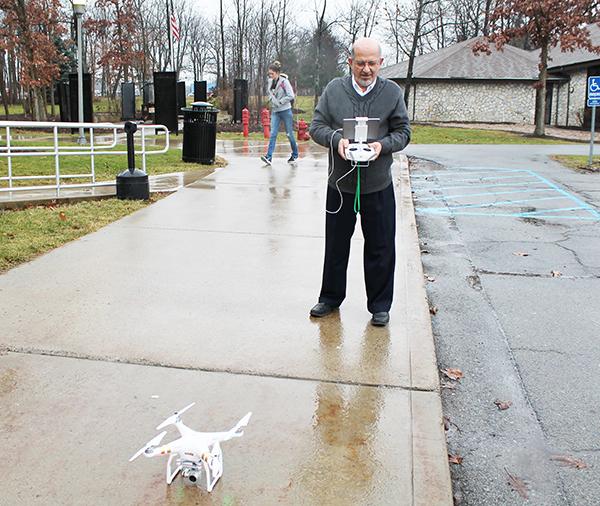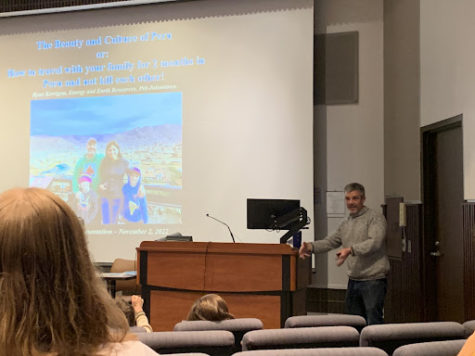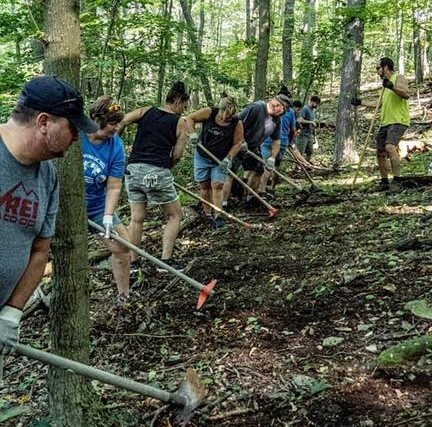Drone use limited by availability

Geography professor Ahmad Massasati prepares to launch his drone Friday. Massasati and students in the Geography Department use the drones to take aerial photos of campus.
January 25, 2017
A flying object above Pitt-Johnstown’s campus mall area can catch students’ attention.
Most likely, it has been a drone.
The drone that hovered above the campus has been remotely flown by students in cartography, geographic information systems and special projects classes.
According to geography professor William Kory, geography students and faculty members have only one drone, and it does not work well.
“It unfortunately breaks down periodically,” said Kory.
“I wish we had at least two or three (drones) so that students’ projects would not get interrupted if one needs repaired for any reason.
Geography professor Ahmad Massasati was the first person at Pitt-Johnstown to purchase a drone for research use, according to Kory.
“After his purchase, the idea of a drone took off and increased research opportunities,” said Kory.
The one drone that Pitt-Johnstown faculty members own is used mainly for taking photographs for the geography department, Social Sciences Division Chair Raymond Wrabley said.
“There are lots of potential uses for the parking study. Our administration may have interest in making use of it.
“We use it to teach students how to collect photography, and just collect photos of the Pitt-Johnstown campus from a drone that is hovering above,” Wrabley said.
Massasati’s drone was critical for six students’ research last semester, displayed at the Pennsylvania Geographical Society conference. Of these, three won awards at the conference.
Third-place winners Emily Platania and Kevin Baker surveyed Krebs parking lot with the drone for their project.
According to their project’s poster, images were taken from 75 meters every hour between 8 a.m. and 5 p.m. during five business days. The group then plotted average occupancy per day and per hour.
Massasati said he hopes to be able to perform this sort of analysis on all campus parking lots.
The drone is for use with educational projects. However, to cover the entire campus would be less of a project, but rather a job that would require funding which he lacks, Massasati said.
He also said he hoped to complete the parking study over the summer with the help of administration dollars for wages and equipment.
According to Massasati, stocking up on drones is not in the university’s budget.
“Drones crash, plain and simple,” said Massasati.
“I have had two major crashes in the past two years with this, and it was expensive to pay for both of the repairs.”
Having two or three more drones on campus would be ideal, according to Massasati.
“Technology is always evolving, and it will always be better to have the better and newer model,” said Massasati.
According to him, three of his students have purchased their own drones.
“The drones cost close to $1,000.
“But, if you buy technology, nobody can stop you, unlike me who is under the university’s rule to contact them with drone news and happenings.”
One rule that Massasati has to follow strictly is the university’s rule to always have Massasati near the drone.
“I do not think I can let my students fly it on their own; I am always there,” said Massasati.
“I want to buy new drones because they will perform a lot better and my students will be trusted with the old one.”
The drone technology is booming, and students show much more interest in the field of study now, said Massasati.
“It is a big advance for Pitt-Johnstown and myself.
“To students, this drone is a joke, but to my generation, this is science fiction.”
Other than the geography department, the drone also caught the attention of other areas of study, such as broadcast journalism.
According to instructor Richard Bukoski, one drone has been available to him.
“Pennsylvania Highlands Community College has one drone that I can use whenever I want,” said Bukoski.










